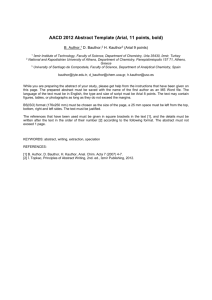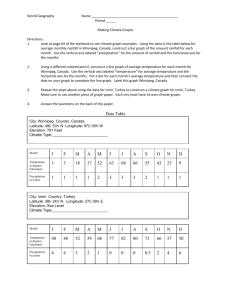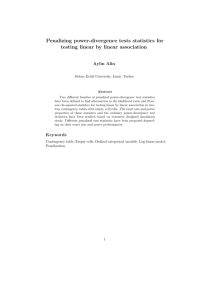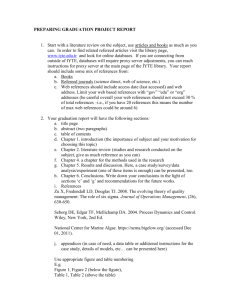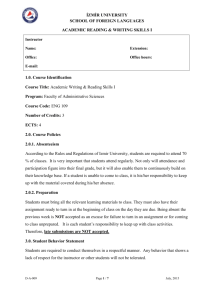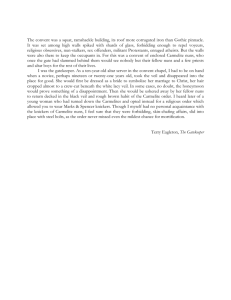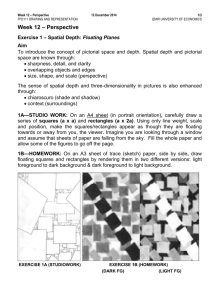İZMİR INSTITUTE OF TECHNOLOGY SCHOOL OF FOREIGN
advertisement
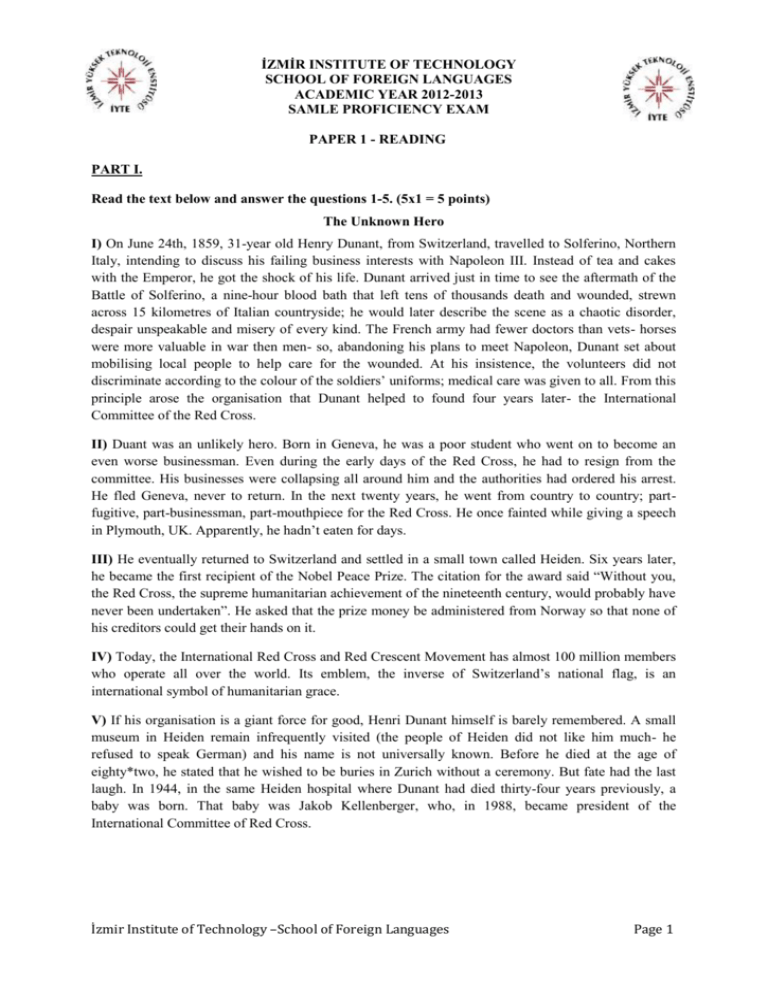
İZMİR INSTITUTE OF TECHNOLOGY SCHOOL OF FOREIGN LANGUAGES ACADEMIC YEAR 2012-2013 SAMLE PROFICIENCY EXAM PAPER 1 - READING PART I. Read the text below and answer the questions 1-5. (5x1 = 5 points) The Unknown Hero I) On June 24th, 1859, 31-year old Henry Dunant, from Switzerland, travelled to Solferino, Northern Italy, intending to discuss his failing business interests with Napoleon III. Instead of tea and cakes with the Emperor, he got the shock of his life. Dunant arrived just in time to see the aftermath of the Battle of Solferino, a nine-hour blood bath that left tens of thousands death and wounded, strewn across 15 kilometres of Italian countryside; he would later describe the scene as a chaotic disorder, despair unspeakable and misery of every kind. The French army had fewer doctors than vets- horses were more valuable in war then men- so, abandoning his plans to meet Napoleon, Dunant set about mobilising local people to help care for the wounded. At his insistence, the volunteers did not discriminate according to the colour of the soldiers’ uniforms; medical care was given to all. From this principle arose the organisation that Dunant helped to found four years later- the International Committee of the Red Cross. II) Duant was an unlikely hero. Born in Geneva, he was a poor student who went on to become an even worse businessman. Even during the early days of the Red Cross, he had to resign from the committee. His businesses were collapsing all around him and the authorities had ordered his arrest. He fled Geneva, never to return. In the next twenty years, he went from country to country; partfugitive, part-businessman, part-mouthpiece for the Red Cross. He once fainted while giving a speech in Plymouth, UK. Apparently, he hadn’t eaten for days. III) He eventually returned to Switzerland and settled in a small town called Heiden. Six years later, he became the first recipient of the Nobel Peace Prize. The citation for the award said “Without you, the Red Cross, the supreme humanitarian achievement of the nineteenth century, would probably have never been undertaken”. He asked that the prize money be administered from Norway so that none of his creditors could get their hands on it. IV) Today, the International Red Cross and Red Crescent Movement has almost 100 million members who operate all over the world. Its emblem, the inverse of Switzerland’s national flag, is an international symbol of humanitarian grace. V) If his organisation is a giant force for good, Henri Dunant himself is barely remembered. A small museum in Heiden remain infrequently visited (the people of Heiden did not like him much- he refused to speak German) and his name is not universally known. Before he died at the age of eighty*two, he stated that he wished to be buries in Zurich without a ceremony. But fate had the last laugh. In 1944, in the same Heiden hospital where Dunant had died thirty-four years previously, a baby was born. That baby was Jakob Kellenberger, who, in 1988, became president of the International Committee of Red Cross. İzmir Institute of Technology –School of Foreign Languages Page 1 1. Which word in paragraph I means “the period of time following something (e.g. war, storm) when people are still dealing with results”? a. disorder b. despair c. aftermath d. later 2. Which word in paragraph III means “someone who receives something”? a. citation b. recipient c. creditor d. achievement. 3. Which word in paragraph I is a synonym of “giving up”? a. mobilising b. intending .c. abandoning d. failing 4. Which word in paragraph V is a synonym of “formerly”? a. previously b. infrequently c. universally d. barely 5. Which of the following is an antonym of the word “apparently” used in paragraph II?”? a. unlikely b. dubiously c. discernibly d. noticeably B) Circle the correct option to complete the sentences. (5x1 = 5 points) 6. Small children are forever asking questions. They have such____________ minds that we may sometimes be puzzled as to how they are asking such questions. a. rebellious b. ambitious c. inquisitive d. obstinate 7. We shouted, but no one replied; the place was completely _________. I must admit that I was scared. a. unspoilt b. deserted c. picturesque d. poky 8. Dad likes noisy towns, but I prefer _________ places where you can relax in peace. That’s why, we cannot go on a holiday together. a. bustling b. ancient c. tranquil d. shady 9. The days of economic _____________ are over, now everybody lives in complete misery suffering from hunger at times. a. income b. measure c. budget d. prosperity 10. Reggae music can be _______________ to its roots in Jamaican folk music of the 1950s. a. traced back b. influenced c. resulted in İzmir Institute of Technology –School of Foreign Languages d. settled Page 2 PART II. Read the text. Answer questions 1- 5 by choosing from the Caribbean Islands (A-D) in the text. The islands may be chosen more than once. (5x1 = 5 points) Which island(s) would you recommend for a holiday maker who… enjoys different kinds of music? 11. _________ enjoys eating peppery food? 12. _________ wants to meet the local population? 13. _________ wants to do a lot of water sports? 14. _________ wants to see the best pink-white sand. 15. _________ YOUR BEAUTIFUL CARIBBEAN HOLIDAY It is said that for every individual dream of faraway sands there is a perfectly matching Caribbean island. For centuries the Caribbean has enchanted and captivated the traveller with the combination of perfect beaches of dazzling white sands, palm trees shaking in the soft winds and a pace of life that is decidedly relaxed. We have selected four of the most popular islands: St. Lucia, Antigua, Jamaica and Barbados. A. St. Lucia A mystical island of volcanic mountains, St. Lucia is a charmed and charming place. Its scenic grandeur is second to none: secret bays of deep sand, sky-high mountain sides covered in dense forestry and whole valleys of banana groves make for dramatic scenery and yet they are upstaged for sheer rarity by its most famous landmark- the twin volcanic cones, called the Pitons. With a history as complex as its tropical greenery and perhaps the friendliest people in the Caribbean, it’s difficult to know if they are a product of the island or the vital ingredient that makes it what it is. Either way, they welcome the visitor with a refreshing enthusiasm- and a spicy traditional cuisine. St. Lucia is undeveloped (as are its roads and services!) and while it remains unspoilt, it may spoil you for anywhere else. B. Antigua It’s said that Antigua has a beach for every day of the year and its rocky coastline of deep inlets, long peninsulas and natural harbours certainly supports the theory. However, it’s a legend that is difficult to prove, for visitors to the island are so quickly intoxicated with the gentle pace, infectious calm and general contentment, that no-one is inclined to do a count. One thing is certain, the coral island of Antigua has the finest shores of pink-white sand in all the Caribbean. Apart from the beach, there is plenty of sightseeing as Antigua’s unsophisticated charm is spellbinding. In the capital, St. Johns, wooden balconies a century old overhang the street and the market is a battlefield where gossip is exchanged with goods. İzmir Institute of Technology –School of Foreign Languages Page 3 C. Jamaica As colourful as its history, as lively as its local reggae rhythm, and as scenic as any island you will find, Jamaica’s magical magnet draws eager visitors to its shores in ever-increasing numbers. Woodland and waterfalls, history and tradition, sun and sports, modern Jamaica has it all. The sugarwhite sands of the north coast resorts are legendary and bordered with offshore coral reefs, providing a wide choice of water-based activity, from snorkelling to jet skiing, scuba diving to parasailing. The landscape too, more than simply beautiful, lends itself to recreation. You can climb the watersmoothed steps of Dunn’s River Falls, play golf on a number of world class courses, go rafting on the Rio Grande. So much more than sun and sand, Jamaica is the Caribbean encapsulated, a rich reserve of holiday resorts. D. Barbados As British as cricket and afternoon tea, as historic as piracy on the high seas, as exotic as calypso and coral reefs, as Caribbean as you could wish, Barbados is a matchless mix of sunshine, sport and sophistication. The sunniest in a sea of tropical treasures, Barbados is blessed with beautiful beaches, where, centuries ago, smugglers and pirates used to land. The fashionable west coast is caressed by the cool Caribbean, while the eastern shoreline is battered by the crashing Atlantic surf. Those who enjoy land sports are well looked after, with championship golf and foodlit tennis courts and on warm Barbados evenings the ‘millionaires’ playground’ of the West Indies comes alive with the characteristic music of steel bands, the cool sound of jazz and the more relaxed Latin American rhythms. Yet the island preserves a certain charm, gentility and sophistication, in classical colonial plantation mansions, in old-world values of courtesy and dress code and the time-honoured tradition of taking life slowly, so it lasts longer… Decide that ‘rushing’ is just something they make baskets from and you’re well on the way to discovering the Barbados spirit. İzmir Institute of Technology –School of Foreign Languages Page 4 PART III. Read the text. Choose the most suitable heading (A-F) for each part of the text (15-19). (5x1 = 5 points) A. A little experiment D. Mathematics, conquest and an alert eye B. A matter of personal space E. Power in decline C. A convincing performance F. A major expedition DEFENDING YOUR TERRITORY ON THE BEACH 0. F The first thing to note is the range of personal belongings that individuals take with them to the beachthe air-beds, beach umbrellas, radios and towels. Whole families arrive totally weighed down with their possessions. They go to a lot of trouble to get them to the beach, lugging huge, heavy umbrellas hundreds of yards or more from their hotel or from their car. 16. _______ Sometimes you can watch a family group for a whole day and discover that not one member of the group has ever sat in the shade below the umbrella which was so heavy and difficult to carry in the first place. Underwater swimming gear has been carried all the way from the hotel and yet no-one ever went underwater swimming. All this equipment has been merely brought to the beach to mark out the new territorial boundaries of this family group. It forms a fence through which strangers cannot pass without first having been invited. 17. _______ And then there is the question of spacing of spacing. The goal seems to be to find a spot equidistant from those already occupying the beach. You can almost see some people doing the various calculations in their head to work out the right spot, an equal distance from those already there. Having worked out the spot, they then plant the umbrella, as if they were planting a flag and claiming the land, like Columbus claiming the New World for Spain. Anyone who seriously breaks this equidistant rule will probably be watched very carefully to try to find out the reason for their unusual action. 18. _______ Smaller things like a towel can, of course, be used to reserve a smaller space on the beach, but very importantly it is a much smaller space. It is fascinating to see how long just one towel will successfully reserve a space on a beach. I decided to try this by placing a towel on a beach early one morning and to sit and watch what happened as the beach started to fill up. 19. _______ To begin with, it was an extremely effective territorial marker. In fact, as couples and groups arrived on the beach you could see them taking the position of the towel into account in their calculations of the best sites for themselves. It was treated with equal respect by passers-by as well. On their way to the sea, they carefully bypassed it. One young French boy accidentally stepped on it and was told off by his mothers. 20. _______ This unfortunate accident marked the beginning of the end of the territorial marking powers of this particular towel and it was noticeable that thereafter passers-by took less care to avoid it. More and more feet stepped closer and closer, until it was nearly covered in sand. Eventually a middle-aged lady walked right over it. The end of the towel was now turned up and it was immediately apparent that all of its remaining powers had now faded. Shortly after this happened, a young couple sat down in the exact spot marked by the towel, and the young man merely threw the sandy and now dirty towel onto some rocks behind the beach. However, it had managed to reserve this space successfully for nearly three hours! İzmir Institute of Technology –School of Foreign Languages Page 5 PART IV. Read the introduction to a book about convent education. Six paragraphs have been removed from the text. Choose from the paragraphs A-G the one which fits each gap (1- 5) There is one extra which you do not need to use. (5 points) A. In a convent school, there was always an enormous temptation to get involved in at some minor misbehaviour because it took so little to reduce the nuns to a state of complete apoplexy. Only the truly compassionate could have resisted it- and who feels compassion towards their teachers in their teens? B. A great deal of thought went into those adaptations. Someone at my school worked out that if you wore a very wide elasticated belt over your dress and then buttoned up your cardigan, the overall effect was of a tiny waist and shorter flared skirt (very fashionable at the time). Of course, it was only a matter of time before one of the nuns decided to investigate. C. The new breed of convent girls appear at best to share a very positive attitude to life and their education. For the most part, academic standards at convents have always been high; but these girls appear to have been encouraged in other ways; to question just about every subject under the sun, and they have been treated as adults. The resulting maturity makes them a credit to their educators. D. These days guilt is automatically assumed to be a bad thing, so most people get rid of it. This is often a problem for convent-educated women: is the guilt just something left over from their school days, something negative to be got rid of, or is it the sign of a healthy conscience? E. Battles fought over the wearing of school uniform seem to remain high in most people’s memory. Britain’s highest ranking woman police officer, Assistant Chief Constable Alison Halford, clearly recalls that at her school, eating in uniform, in the street, ‘was almost a capital offense’. F. Yet without that particular side to their character, it is doubtful that many of the original founders of religious orders would actually have got their projects started in the first place, given their battle with men who often had a very negative view of the whole idea. G. In reality we know the nuns were too busy to spend much time sharing information, even within the same school, much less outside of it, so it is all the more extraordinary that women educated in Melbourne, Bombay, New York and Dublin are as much united by similar memories of their school days as they are separated by years or the continents that divide them. İzmir Institute of Technology-School of Foreign Languages Page 6 THERE IS SOMETHING ABOUT A CONVENT GIRL Rosemary Forgan explains what makes a convent education special. The things you hear, or indeed remember from personal experience, about convent education may strike you as bizarre, inspiring or brutal according to one’s stand on these matters, but what is quite breathtaking to most people is the similarity of the experience. Unlikely as it sounds, it was as if women in religious orders, not just in Britain but all over the world, conspired to produce an identical female educational system that hardly changed in 150 years. For decades it must have seemed as if nuns were busying about in every corner of the world, worrying over the length of girls’ skirts, urging them to eat unpalatable food and, most important of all, alerting them to the dangers lying in wait in the outside world. 0.G The other thing that strikes a lot of people is how, with all the emphasis on humility, modesty and the putting of almost everybody before oneself, the nuns managed to produce so many extraordinarily strong-minded women. 21. _______ There seems little doubt that one aspect of convent education that appeals to parents is the idea of a school uniform. In turn the efforts made by daughters to liven it up a bit, or even to make it a bit more modern, deserve awards for creativity. 22. _______ Nuns seemed to spend a lot of their time like this, doing detective work, looking for something wrong- based on no more than a feeling that something was going on. On many occasions, of course, their intuition was absolutely right. 23. _______ But what really separated the convent school from any other was the sense of guilt which children were made to feel if they failed to reach the required standards in all things. And of course, unless you are guilty of the sin of pride, you will assume you don’t reach the required standard. 24. _______ So much has changed as far as convent schools are concerned that it would probably be difficult for today’s convent girls to identify with previous generations of convent girls and their school experiences. Nowadays their manner, their attitudes, their aspirations and ambitions are almost unrecognisable to those educated in previous generations of convent schools. 25. _______ What they haven’t had, however, is an education occasionally so insane that one had no choice but to rebel, thus sampling at an early age the heady delights of rebellion! However, maybe today’s convent education is closer to the ideals of the early founders, enabling children to fulfil their potential free of the heavy burden of guilt. İzmir Institute of Technology-School of Foreign Languages Page 7 PART V. Read the texts below and choose the correct answer. (15x1= 15 pts.) Text I: Secrets from Time Past We had been in the old French farmhouse barely two months when my husband received the most terrible news. He was poorly, and, as it turned out, he had only a few months to live. You can imagine then that the following months, living alone in the French countryside, were difficult. When the long winter was over, I decided to clear out the house and re-arrange the furniture, putting fresh paint on the walls and re-planting the garden. I wanted the house to look as my husband would have liked it. It was when I took the heavy wooden doors off the antique dresser in the kitchen that I found a small brown package, tucked up into one of the corners. It was a handful of letters, some hand-written, others typed. They had been wrapped in brown greaseproof paper. I sat at the old kitchen table and carefully unwrapped them one by one. The letters were dated 1917 and were the correspondence between a British mother and her solider son, who had obviously been sent to France during the First World War. As I read the words sent between the two, I wept. The first was a letter from the mother, in which she seems quite oblivious to the hardships her son is having to endure on the front line. She complains of the price of coal and vests, but most poignantly, she bitterly criticises the behaviour of the young soldier’s wife, now heavily pregnant. She complains that the young wife did not invite her mother-in-law to spend time with them before the soldier left for France. I read the son’s reply to his mother, in which he calmly explains his love for his wife and their desire to spend time alone now that they are married. He ends by imploring his mother to have more patience, and be more open-minded and understanding towards his new wife. He says “Now is not the time for quarrelling. If you were in my position, or my brother’s, you would realise more fully what is to be miles away from your own fireside, not knowing when death may overcome you.” It was the most extraordinary feeling to hold the letters in my hands. I felt as if I was intruding on their most private correspondence- secrets from the past- and I so desperately hoped that the young man had returned safely home to his loved ones. I have since been trying to contract the family. I am hoping that perhaps one of the grandchildren or great grandchildren will be alive today, and I can pass on the letters, which form such an intimate part of their family history. 26. Where did the writer find the letters? a. In the corner of the kitchen b. In the corner of an old dresser c. Under a door in the kitchen d. In the drawer of an old dresser 27. a. b. c. d. Why were the early months in France difficult? She couldn’t speak the language She was living in the middle of nowhere Her husband was dying She was homesick 28. a. b. c. d. What kind of letters were they? Official letters from the army a soldier’s family Personal family correspondence Love letters from a soldier Official letters from the government to a soldier 29. a. b. c. d. Why was the mother’s letter inconsiderate? She tells her son private information about his wife She did not give a thought to the price changes that were happening She seemed unaware of how difficult things were for her son She complains about her son being away İzmir Institute of Technology-School of Foreign Languages Page 8 30. a. b. c. d. Which cannot be inferred from the reading text? The woman found the old correspondence of a family in her house by chance. The woman took his husband’s likes and dislikes into consideration while redecorating the house. The woman felt uncomfortable reading the private letters of family members whom she never met. The grandchildren of the family whose letters the woman had found in the house are highly probably alive. 31. The word “oblivious” in paragraph 2 is closest in meaning to a. Unconcerned b. Forgetful c. Distracted d. Careless 32. Which is TRUE about the passage? a. The woman knew in advance that her husband did not have much time left. b. The woman and her husband had been living in the French countryside for more than two months when they received the bad news. c. The woman got emotional as she read the letters sent between the mother and son. d. The soldier was the sole family member who was at the front line during the war. 33. The word “quarrelling” in the text is closest in meaning to a. Disapproving b. Disputing c. Mistreating d. Abusing İzmir Institute of Technology-School of Foreign Languages Page 9 Text II The Melting Pot The USA is a land of immigrants. Between 1815 and 1914, the world witnessed the greatest peaceful migration in its history. 35 million people, mostly Europeans, left their homelands to start new lives in America. Why did these people risk everything they have by leaving their homes and families to see what the New World had to offer? How had the Old World let them down? There are both push and pull factors which we should consider. First, what forced emigrants to make the momentous decision to leave? One major cause of the exodus among European peasants was the rise in population which in turn led to land hunger. Another was politics. Nationalism saw increased taxation and the growth of armies, and many young men fled eastern Europe to avoid being conscripted. Also, the failure of the liberal revolutions in Europe caused the departure of hundreds of thousands of refugees. Physical hunger provided another reason. Between 1845 and 1848, the terrible potato famine in Ireland ended in the deaths of one million Irish people and the emigration of a further million who wished to escape starvation. Following the collapse of the economy of southern Italy in the 1860s, hundreds of thousands decided to start afresh in America. Religion was also a pressing one. It encouraged millions to leave the Old World. We should remember that the Pilgrim Fathers had wished to escape the ungodliness of England, while the Russian Jews of the last century sought to escape persecution and death in their native land. In short, people chose to leave their homes for social, economic and religious reasons. As a result, by 1890 among a total population of 63 million, there were more than nine million foreign-born Americans. But what were attractions? First of all, there was the promise of land which was so scarce in Europe. Next, factories were calling out for labour, and pay and conditions were much better than back home. Men were needed to open up the West and build the long railroads. Settlers were needed to populate new towns and develop commerce. There was the space for religious communities to practise their faith in peace and comparative isolation. This immigration meant that by around the 1850s Americans of non-English extraction had started to outnumber those of English extraction. As we know, there were losers. To start with, there were those unwilling immigrants, the slaves who had been used as a source of cheap labour for the tobacco plantations of the South. Nor should we forget the equally awful fate of the American Indians. By 1860 there were 27 million free whites, four million slaves and a mere 488,000 free blacks. Nowadays, the USA is still seen by millions as the Promised Land. Gone are the days when you could buy US citizenship for one dollar. Yet, even though entry is strictly limited, refugees continue to find freedom and people from poorer countries a better way of life. As always, it remains a magnet to the ambitious and the energetic who are ready to commit themselves to the land that gives them a second chance. 34. What is not given as a reason for emigration in the text? a. The search for religious freedom b. The search for adventure c. Avoidance of military service d. Economics 35. The lives of 19th century European peasants were difficult because …………………… a. there was no shortage of land b. of peace. c. the population had gone down. d. there were too many of them. 36. “Exodus” in paragraph 2 is closest in meaning to a. alteration b. discrimination c. immigration d. population İzmir Institute of Technology-School of Foreign Languages Page 10 37. Which of these things was not a benefit of moving to the USA? a. Employment b. A healthy life c. Availability of land d. Business opportunities 38. Which fraction gives the closest estimate of the number of non-native born Americans in 1890? a. A third b. An eighth c. A half d. A quarter 39. The story of the American Indians is …………………………… a. sadder than that of the slaves. b. the saddest tale of all. c. not as sad as that of the slaves. d. as sad as that of the slaves. 40. “One” in paragraph 4 refers to a. reason b. problem c. urge d. practice İzmir Institute of Technology-School of Foreign Languages Page 11 İZMİR INSTITUTE OF TECHNOLOGY SCHOOL OF FOREIGN LANGUAGES ACADEMIC YEAR 2012-2013 PROFICIENCY EXAM PAPER 2 - LANGUAGE USE PART I. A) Read the text and circle the best option that is suitable for each gap. (10x1=10 pts.) Trees are amongst the biggest and longest-living things on Earth, some (41) _______ back longer than the oldest buildings. But (42) _______ being nice to look at, tree also play an important role in improving the quality of our lives. On a world-wide (43) _______, forests help to slow down the effects of global warming by using up the gas (44) _______ as carbon dioxide and giving (45) _______ the oxygen we need to breathe. At local neighborhood level, trees also bring important environmental benefits. They offer shade and shelter, which in (46) _______ reduces the amount of energy needed to heat and cool (47)_______ buildings; at the same time, they also remove other impurities from the air we breathe. Urban trees are especially important because for many people they provide the only daily contact with the natural world. What’s (48) _______, urban trees also provide a home for birds, small animals and butterflies. (49) _______ the trees we could lose the pleasure of seeing these creatures in our cities. Unfortunately, (50) _______, trees in cities are now coming under threat. 41. A) dating B) ageing C) growing D) stretching 42. A) as far as B) as long as C) as soon as D) as well as 43. A) scale B) size C) range D) area 44. A) called B) known C) titled D)referred 45. A) in B) away C) up D) out 46. A) turn B) place C) order D) reach 47. A) opposite B) close C) next D) nearby 48. A) more B) else C) most D) other 49. A) Throughout B) Beyond C) Without D) Outside 50.A) therefore B) whilst C) however D) despite İzmir Institute of Technology-School of Foreign Languages Page 12 B) Read the text and circle the best option that is suitable for each gap. (10x1=10 pts.) Can we see (51) _______ the earth is a globe? Yes, we can, when we watch a ship that sails out to sea. If we watch closely, we see that the ship begins (52) _______ . The bottom of the ship disappears first, and then the ship seems to sink lower and lower, (53) _______ we can only see the top of the ship, and then we see nothing at all. What is hiding the ship from us? It is the earth. Stick a pin most of the way into an orange, and (54) _______ turn the orange away from you. You will see the pin disappear, (55) _______ a ship does on the earth. Is it interesting? Definitely, yes! Humankind (56) _______ on Earth for centuries; (57) _______, they are not aware of the perfect clues. All (58) _______ the world, everyday life gives us clues about (59) _______ we are, in (60) _______ kind of a shape we live. 51. A) if B) where C) that D) whether 52. A) being disappeared B) to be disappeared C) to disappear D) disappearing 53. A) until B) since C) by the time D) after 54. A) reluctantly B) slowly C) passionately D) accidentally 55. A) the same B) alike C) just as D) similar to 56. A) has lived B) lives C) had lived D) had been living 57. A) but B) however C) in fact D) actually 58. A) about B) above C) around D) away 59. A) who B) which C) that D) where 60. A) which B) that D) who D) what PART II. There are 10 errors in the text below. Find the errors among the boldfaced, underlined items. (10x1=10 pts.) Hardly a day goes by without a fresh demonstration of the ignorance of American’s first video generation. (61) A) Illiteracy is growing, and a new B) poll shows that a quarter of university students have C) any idea D) when Columbus reached America. (62) A) The institutions, B) at least, have C) until now been presumed to be D) above the decay. (63) It was A) imagined, for example, that they B) have still been reading books C) at Harvard D) for years. (64) A) Almost that illusion, B) too, C) has been shattered by Professor Sven Birkerts, D) who teaches Creative Writing to undergraduates there. (65) “Almost none of my students A) read independently,” he says B) in a powerful lament C) which has D) just been published by Harvard Magazine. (66) A) Every year, he says, he B) makes a survey C) among his students, and “ D) the responses are heartbreaking”. (67) The Harvard undergraduates A) studying under Professor Birkerts are, B) to put it no higher, reluctant readers, C) who interests D) are lower. (68) The printed page A) taxes and wearies them. I read B) of their first papers, C) so neatly word- processed, and my heart D) sinks, “ he writes, adding: “ He doesn’t think it is a serious problem” (69) Professor Birkerts said A) yesterday that the trend away from reading seemed to B) have reached a critical stage, “ It’s merely that they are C) any longer receiving the world D) through the medium of print,” (70) Professor Birkerts wonders A) what his students imagine they can learn B) to write without C) bothering to read, “Too busy” I wish I D) had the time. İzmir Institute of Technology-School of Foreign Languages Page 13 İZMİR INSTITUTE OF TECHNOLOGY SCHOOL OF FOREIGN LANGUAGES ACADEMIC YEAR 2012-2013 PROFICIENCY EXAM PAPER 3 - LISTENING PART I. You will listen to a dialogue once. Listen and match 1-5 with A-E. There is one extra. Make sure you mark your answers on the separate answer sheet. (5x1 = 5 points) 71. 72. 73. 74. 75. Greenberg Parliamentary report Dennison Hampton Frick A) B) C) D) E) F) Financial information Psychology of art Art and other media Modern art History of art The art market ....... ....... ....... ....... ....... PART II. Listen to the lecture ONCE and choose the correct answer. (5x1 = 5 points) 76. a) b) c) d) 77. a) b) c) d) 78. a) b) c) d) 79. a) b) c) d) 80. a) b) c) d) How long would terms be under the six-term system? Six weeks Seven weeks Ten weeks Thirteen weeks What would happen to the summer holiday? It would not be affected. It would disappear. It would be shortened. It would be lengthened. How much was the average learning loss in the summer? Two weeks Four weeks Seven weeks Three weeks. In which subject was learning loss greatest among disadvantaged children? Maths Reading Language Arts Writing According to Marchmont’s research, in the six-term system pupils performed Better than under the existing system. Worse than under existing system. Totally differently that it cannot be compared with the existing system. The same as under existing system. İzmir Institute of Technology-School of Foreign Languages Page 14 İZMİR INSTITUTE OF TECHNOLOGY SCHOOL OF FOREIGN LANGUAGES ACADEMIC YEAR 2012-2013 PROFICIENCY EXAM PAPER 4 – WRITING Write an essay of 250-300 words on ONE of the topics below. Your essay must have an introduction/a clear thesis statement with controlling ideas, at least 2 body paragraphs with relevant supporting ideas and a conclusion. Make sure that your ideas are organized properly (20 points). 1. We are becoming increasingly dependent on computers. Do you think the dependence on computers is a good thing or should we be suspicious of its benefits? 2. The Internet allows us to download music or films for free. Given the importance of copyright issues, do you think it is ethical to download songs and films gratuitously? THIS IS THE END OF THE EXAM. İzmir Institute of Technology-School of Foreign Languages Page 15 İZMİR INSTITUTE OF TECHNOLOGY SCHOOL OF FOREIGN LANGUAGES ACADEMIC YEAR 2012-2013 SAMLE PROFICIENCY EXAM- ANSWER KEY 1) C 2) B 3) C 4) A 5) B 6) C 7) B 8) C 9) D 10) A 11) D 12) A 13) A 14) C 15) B 16) B 17) D 18) A 19) C 20) E 21) F 22) B 23) A 24) D 25) C 26) A 27) C 28) B 29) C 30) D 31) A 32) C 33) B 34) B 35) D 36) C 37) B 38) B 39) D 40) A 41) A İzmir Institute of Technology-School of Foreign Languages 42) 43) 44) 45) 46) 47) 48) 49) 50) 51) 52) 53) 54) 55) 56) 57) 58) 59) 60) 61) 62) 63) 64) 65) 66) 67) 68) 69) 70) 71) 72) 73) 74) 75) 76) 77) 78) 79) 80) D A B D A D A C C C C A B C A B C D D C A B A A B C B C A D A F C B B C D B A Page 16

